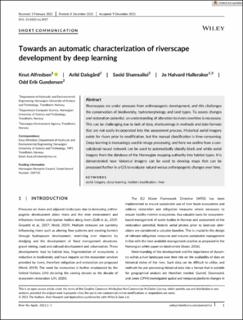| dc.contributor.author | Alfredsen, Knut | |
| dc.contributor.author | Dalsgård, Arild | |
| dc.contributor.author | Shamsaliei, Saeid | |
| dc.contributor.author | Halleraker, Jo Halvard | |
| dc.contributor.author | Gundersen, Odd Erik | |
| dc.date.accessioned | 2022-02-14T13:30:46Z | |
| dc.date.available | 2022-02-14T13:30:46Z | |
| dc.date.created | 2021-12-29T11:21:44Z | |
| dc.date.issued | 2021 | |
| dc.identifier.citation | Rivers Research and Applications: an international journal devoted to river research and management. 2021, 1-7. | en_US |
| dc.identifier.issn | 1535-1459 | |
| dc.identifier.uri | https://hdl.handle.net/11250/2978849 | |
| dc.description.abstract | Riverscapes are under pressure from anthropogenic development, and this challengesthe conservation of biodiversity, hydromorphology and land types. To assess changesand restoration potential, an understanding of alteration to rivers overtime is necessary.This can be challenging due to lack of data, shortcomings in methods and data formatsthat are not easily incorporated into the assessment process. Historical aerial imageryexists for rivers prior to modification, but the manual classification is time-consuming.Deep learning is increasingly used in image processing, and here we outline how a con-volutional neural network can be used to automatically classify black and white aerialimagery from the database of the Norwegian mapping authority into habitat types. It isdemonstrated how historical imagery can be used to develop maps that can beprocessed further in a GIS to evaluate natural versus anthropogenic changes over time. | en_US |
| dc.description.abstract | Riverscapes are under pressure from anthropogenic development, and this challenges the conservation of biodiversity, hydromorphology and land types. To assess changes and restoration potential, an understanding of alteration to rivers overtime is necessary. This can be challenging due to lack of data, shortcomings in methods and data formats that are not easily incorporated into the assessment process. Historical aerial imagery exists for rivers prior to modification, but the manual classification is time-consuming. Deep learning is increasingly used in image processing, and here we outline how a convolutional neural network can be used to automatically classify black and white aerial imagery from the database of the Norwegian mapping authority into habitat types. It is demonstrated how historical imagery can be used to develop maps that can be processed further in a GIS to evaluate natural versus anthropogenic changes over time. | en_US |
| dc.language.iso | eng | en_US |
| dc.publisher | Wiley | en_US |
| dc.rights | Attribution-NonCommercial-NoDerivatives 4.0 Internasjonal | * |
| dc.rights.uri | http://creativecommons.org/licenses/by-nc-nd/4.0/deed.no | * |
| dc.title | Towards an automatic characterization of riverscape development by deep learning | en_US |
| dc.type | Peer reviewed | en_US |
| dc.type | Journal article | en_US |
| dc.description.version | publishedVersion | en_US |
| dc.source.pagenumber | 1-7 | en_US |
| dc.source.journal | Rivers Research and Applications: an international journal devoted to river research and management | en_US |
| dc.identifier.doi | 10.1002/rra.3927 | |
| dc.identifier.cristin | 1972632 | |
| dc.relation.project | Norges forskningsråd: 289725 | en_US |
| cristin.ispublished | true | |
| cristin.fulltext | original | |
| cristin.qualitycode | 1 | |

